On 14 September 2012, the RIPE NCC started allocating IPv4 addresses based on the last /8 policy. With more than two years passed, we look at the effects this had on membership numbers and demographics. We also look at what the last /8 policy meant for IPv6 uptake.
Introduction
In January 2011, shortly before IANA allocated the last /8 blocks of IPv4 address space to the Regional Internet Registries (RIRs), the RIPE community accepted a policy proposal that set aside the RIPE NCC's final /8 as well as any future reclaimed space to help organisations bridge the time until there is an IPv6-only Internet. By restricting allocations to one (last) single /22 per Local Internet Registry (LIR), the policy aims to ensure new entrants can still obtain a small, routable block of IPv4 address space during the transition to IPv6. The policy change came into effect on 14 September 2012, when the RIPE NCC's pool of available IPv4 address space had shrunk to one /8. In this article, we examine the effects this policy had on the composition of the RIPE NCC membership as well as the deployment of IPv6.
Membership growth
The first statistic we look at is the evolution of the number of LIRs over time. Usually, there is a one-to-one relationship between members and LIRs. However, for perfectly valid reasons it is possible for a single organisation to operate multiple LIRs. Multinational organisations, for example, might choose to manage their Internet operations with a set of LIRs, each based in a different country. Because the LIR as an entity is central to RIPE NCC fees and services, the growth in the number of LIRs is more interesting to track than the growth in members, which are the distinct legal entities that operate the LIRs.
The blue line in Figure 1 shows the total number of active, not closed LIRs over time. Note that the line is not monotonically increasing and has a number of small dips; these happen at regular intervals when the RIPE NCC closes LIRs with unpaid invoices. LIRs are also closed by the members themselves, for instance when the business closes down or after a merger with another LIR. However, those events are spread out more evenly over the years and, as such, are not visible in the graph.
Comparing the periods before and after the RIPE NCC free pool of IPv4 addresses reached the level of a /8, we see the net growth was close to linear in both the 2006-2012 and 2013-2015 time frames; the red and green straight line segments highlight this. However, the growth rate in these two periods shows a sharp difference. In the years before September 2012, the RIPE NCC saw approximately 600 new LIRs per year. After September 2012, this rate almost doubled: from 1 January 2013 to 31 December 2014, the net growth was 2,369 LIRs, an average of 1,184 per year.
What seems to be happening is that organisations which in 'the years of plenty' would have satisfied their IPv4 addressing needs with either an assignment from an upstream provider or with Provider Independent space from the RIPE NCC, are now choosing to become a member. As an LIR of their own they can still obtain a much-needed /22 IPv4 allocation from the RIPE NCC.
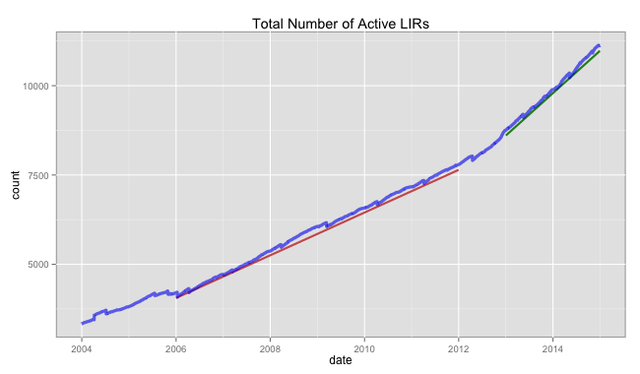
While Figure 1 shows that the rate at which the number of active LIRs has been growing recently is only slightly above linear, the rate at which new LIRs are established is significantly higher. In the last two years, almost 3,000 LIRs signed up with the RIPE NCC. With 630 LIRs closing (142 of which had actually joined in these same years), the net growth in these years was reduced to 2,364 additional LIRs. Reasons for closure could be merging with another LIR, acquisition by another LIR, failure to pay membership fees or simply business closure.
In Figure 2, we take a more detailed look at the age distribution of both open and closed LIRs per 1 January 2015. In the bar graph, we group the LIRs by the date they signed a service agreement with the RIPE NCC. The height of each bar represents the total number of active and closed LIRs who signed up in the three-month period shown on the x-axis. Within each bar, the coloured segments show the current state of the LIRs: the red part represents LIRs that were closed at some time in the past, the yellow part represents the LIRs that were active and open at the start of 2015.
Over the past three years, we observe a steadily rising trend: with only a few exceptions, each quarter sees more LIRs signing up than the quarter just before. This means the recent growth rate of new LIRs is quadratic in nature - a rate that is dampened only by other LIRs closing at the same time.The net result of this trend is an accelerated shift in demographics towards a younger membership. On 1 January 2015, 49% of all LIRs had been members for five years or less.
The distribution of closed LIRs, as represented by the red bars in Figure 2, shows LIRs of all ages are closing: not only older ones, but also younger LIRs that signed up in the last few years. This is most prominently seen in the last quarter of 2014 (the very last bar in the graph). Although a record number of 468 new LIRs signed up in this quarter, 38 of them (about 8%) had already closed by 1 January 2015. This is the first time we see such a closure rate for very young LIRs.
Upon further inspection, we find that of the LIRs that closed in the last three months, all had obtained an allocation from the last /8. These allocations all moved to other LIRs by transfer or merger prior to closure. We also find that 31 of the 38 LIRs are based in Russia; they were established by just three different organisations (legal entities) who set up multiple LIR accounts to be able to apply for more IPv4 address space.
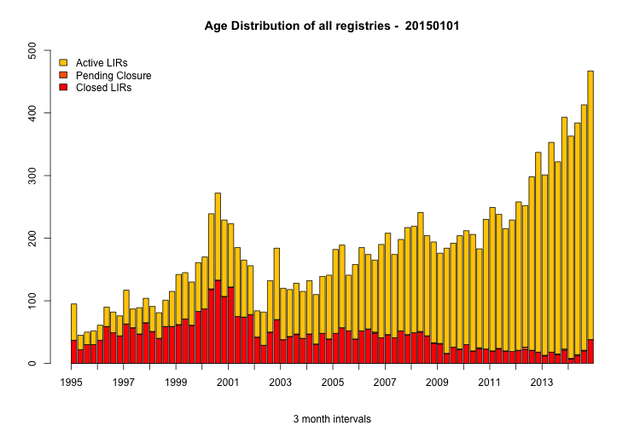
Figure 2 : Distribution of LIRs' present state vs. the date of signing up
Growth rates are not the same throughout the RIPE NCC service region. Figure 3 shows the age distributions of LIRs in Western Europe, Eastern Europe (including Russia) and the Middle East as well as for LIRs that have their legal address outside the RIPE NCC service region. Organisations in the last category can obtain IP and ASN resources from the RIPE NCC under the condition that the resources are used in the RIPE NCC service region. The first three groups all show accelerated growth in the establishment of new LIRs. Most striking is the sharp rebound from the downward trend that was observed in Eastern Europe in the wake of the credit crisis. This coincides with the implementation of the last /8 policy in September 2012. Because assignment of Provider Independent IPv4 addresses was no longer possible, it may have triggered organisations to join the RIPE NCC and thus become eligible for an allocation from the last /8.
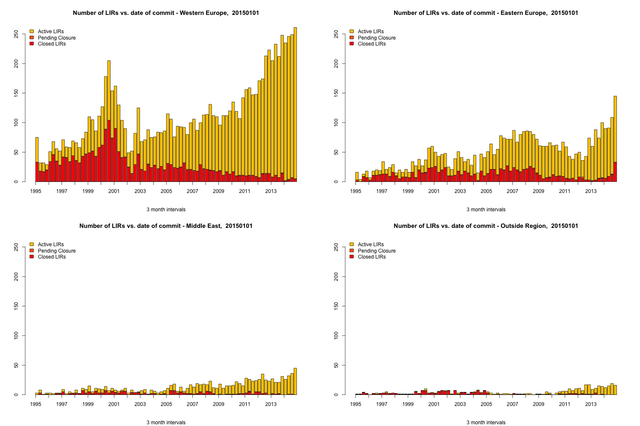
.
Distribution of countries
In Figure 4 we compare the distribution of countries LIRs are based in as observed on 1 January 2015. The pie chart on the left shows the distribution for LIRs that joined before the RIPE NCC reached the last /8; the chart on the right shows the distribution for those LIRs that joined afterwards. In both groups, the United Kingdom, Russia, Germany, Italy, France and the Netherlands account for roughly 50% of all LIRs. However, in relative terms Russia, Germany and Italy have a smaller presence among the new LIRs than they had with the established LIRs. The percentages of LIRs from the Netherlands, France and especially the United Kingdom on the other hand increased with respect to those for the older LIRs.
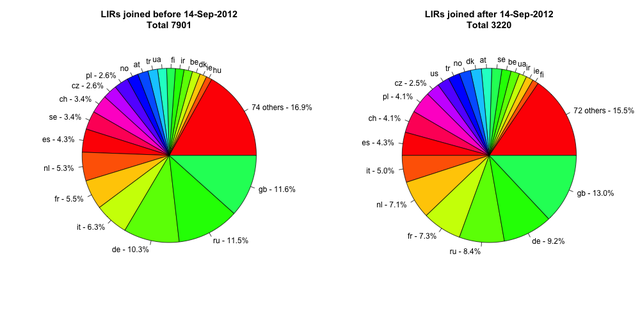
Industries
When signing up with the RIPE NCC, LIRs can specify the industry in which they are active. The relevant form offers a number of categories to choose from, but it also allows LIRs to enter new values of their own. In addition, it is possible for an LIR to choose more than one industry. Both options make it harder to derive meaningful statistics from this data. Nevertheless, the side-by-side comparison of older (before 14 September 2012) and younger LIRs in Figure 5 does provide some hints at underlying trends. We see the hosting categories have become the most selected industries. Broadband, VoIP and IP transit are in decline: these categories have a smaller presence among the LIRs that signed up after the RIPE NCC reached the last /8. This supports the theory that many of the new LIRs which come to the RIPE NCC for a final /22 of IPv4 are relatively small organisations that need a block of IP addresses to connect to the Internet.
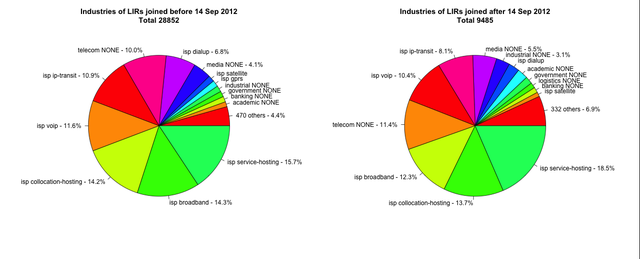
LIRs without resources
Because IPv4 address space is still a necessity in the transition phase to an IPv6-only Internet, it is generally believed that organisations join the RIPE NCC to obtain IPv4 allocations, even when each new LIR now can get only a single /22 allocation or 1,024 addresses from the RIPE NCC. For the large majority of LIRs, this indeed holds. 88% of the LIRs that signed up after 14 September 2012 and were still active on 1 January 2015 have received their final /22 allocation.
However, this also means that 12% (392) of the new LIRs did not hold a final /22 IPv4 allocation at the start of 2015. This could have various reasons:
- The LIR joined recently and is still in the process of requesting an IPv4 allocation
- The LIR already has IPv4 space and joined to receive IPv6 addresses or an AS number
- The LIR did request the final /22 but the allocation was transferred to another organisation
- The LIR joined to receive a transfer from another LIR
When we exclude LIRs that became members less than six months ago, and check for possible IPv4 transfers as well as for allocations and assignments of IPv6 and AS numbers, we find 73 of the new LIRs without any resources at the start of 2015. Although they had been members for between six and 21 months, these LIRs had not (yet) received any IPv4 or IPv6 allocation, either from the RIPE NCC or via transfers; nor did they ever had an AS Number. The organisations in question may need more time to request address space or they joined the RIPE NCC for another reason.
IPv4 Allocations
According to the policy for the last /8, each LIR is entitled to one final /22 allocation of IPv4 addresses. Between 14 September 2012 and 1 January 2015, the RIPE NCC made 5,191 such allocations. Because some of the address space came back upon closure of LIRs, the 5,191 allocations involve 5,175 unique address blocks. Most of the returned /22s have been re-allocated to other LIRs after a quarantine period expired.
Although the policy calls for one /22 per LIR, transfers and mergers do make it possible for a single LIR to hold more than one allocation from the last /8. Figure 6 shows the distribution of the number of "final /22" allocations per LIR. The graph on the left demonstrates how the large majority of LIRs with IPv4 addresses from the last /8 indeed have one allocation. However, zooming in on the tail of the distribution, the graph on the right shows a small number of LIRs that hold five or more allocations. The highest number of 21 final /22 allocations is held by an LIR that opened, merged and closed several new LIR accounts in the last quarter of 2014.

There might be good reasons for an organisation to open multiple LIRs. However, setting up twenty relatively short lived LIRs just for the sake of harvesting IP blocks from the last /8 does go against the spirit of the last /8 policy. If every LIR in need of extra IPv4 address space would go the same multi-LIR route, the last /8 would be used up quite soon. That would make it harder for new entrants to obtain even a small /22 block of IPv4 addresses, as the only place left to go would be the more costly transfer market.
Note that a new policy proposal is currently being discussed by the RIPE community (see policy proposal 2015-01 "Alignment of Transfer Requirements for IPv4 Allocations"). The goal is to delay resource transfers and with that also increase the financial burden associated with opening multiple LIRs. The proposal does not address consolidating /22s from multiple LIR accounts into a single LIR via mergers and acquisitions. The rules governing that process are set by the RIPE NCC membership.
IPv6 Allocations
One of the conditions LIRs must meet in order to obtain a /22 allocation from the last /8 states that the LIR must already have received an IPv6 allocation from the the RIPE NCC or from an upstream LIR. The motivation for adding this requirement was to encourage LIRs who request a final block of IPv4 space to also start using IPv6. Two years later, it is interesting to see what effect this policy had. Have those LIRs that requested their final /22 of IPv4 address space and received an IPv6 allocation in the process made more steps on the path to IPv6 deployment?
We checked the IPv6 RIPEness rating of all LIRs, which awards stars based on whether LIRs obtained IPv6 space, announced it in BGP, created a route6 object in the RIPE Routing Registry and set up reverse delegation in the DNS. This four-star rating system has been in operation since April 2010. In 2013, we started measuring indicators of IPv6 deployment too: a fifth star . However, because the fifth star depends on external data sets which do not necessarily capture IPv6 deployment activity by all RIPE NCC members, it is less suited to comparing one group of LIRs against another. For the purpose of evaluating possible effects of the IPv6 requirement in the last /8 policy, we therefore use results from the four-star ratings only. Although reaching four stars does not guarantee an LIR is ready to offer IPv6 services, it does indicate some measurable steps have been made.
In Figure 7 below, we group LIRs by the date they received their (first) IPv6 allocation along with their IPv6 RIPEness ratings. The total height of each bar in the graph shows the number of LIRs that received a first IPv6 allocation in the three-month period listed on the x-axis. Within each bar the coloured segments represent the number of LIRs with one, two, three and four stars in that group .
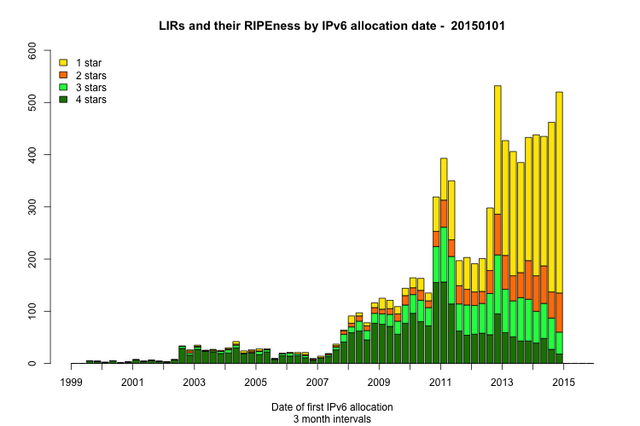
The graph shows two surges in IPv6 activity: from late 2010 to mid 2011 and from September 2012 onwards. The first relates to IANA delegating the last /8s to the RIRs. The publicity leading up to and following this event possibly triggered more LIRs to request IPv6 from the RIPE NCC. The second surge of IPv6 allocations began when the RIPE NCC reached the last /8 (on 14 September 2012). While some LIRs might have seen this event as a wake-up call to at least explore IPv6, the majority of the new IPv6 allocations have probably been made as a direct effect of the policy for IPv4 allocations from the last /8: both old and new LIRs were required to have an IPv6 allocation before they could receive a last allocation of IPv4. When we look at the numbers, we find that by 1 January 2015, 85% of those LIRs that received their first IPv6 allocation after 14 September 2012 had also received their final /22 of IPv4 space.
In terms of IPv6 RIPEness, the graph suggests a divide into four groups. First are the early adopters who got IPv6 in the years 1999-2007. Although small in number, these LIRs score quite well - only a handful are left at one or two stars. The second group received their IPv6 allocation roughly from the start of 2007, when IPv6 allocation activity really started to take off, until the last quarter of 2010. This group is somewhat less "RIPE": a visible fraction of the LIRs is at one, two and three stars. Group three starts with the surge in allocations related to IANA run-out and ends in the third quarter of 2012 when the RIPE NCC had reached the last /8 of IPv4. Although the 9 months around the IANA run-out date show the highest absolute number of four-star RIPEness LIRs, group three also has a sizable fraction of LIRs that were stil at one- or two-star IPv6 RIPEness on 1 January 2015 . Finally, the last group shows those LIRs that received an IPv6 allocation in times where the policy for the last /8 was fully in effect. Much more than others, these LIRs are predominantly at one- or two-star IPv6 RIPEness at the start of 2015, which means they have an IPv6 allocation but have not yet done anything with it (at least nothing that we can measure).
To better examine possible effects of the policy for the last /8, we determine the relative level of IPv6 RIPEness, the percentages of LIRs with different scores, for three adjacent periods of two years each. In addition, the last group only includes LIRs who aside from the IPv6 allocation also received an IPv4 allocation from the last /8. Figure 8 shows the results. Most striking are the differences in percentages of LIRs with four-star and one-star RIPEness in the 2008-2010 vs. 2012-2014 timeframes. As a group, those LIRs who requested IPv6 allocations well before the last /8 policy came into effect have been doing more with their allocations than those who received an IPv6 allocation in conjunction with their final IPv4 allocation directly from the RIPE NCC.
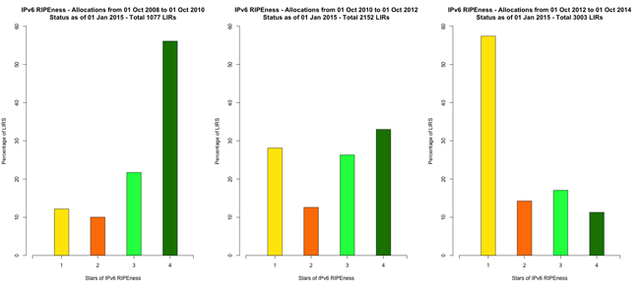
It is tempting to attribute the observed differences in IPv6 RIPEness to the policy that made IPv6 allocations a mandatory requirement for a last IPv4 allocation. After all, before that policy came into effect, only half of the LIRs requested an IPv6 allocation. However, as plausible as the explanation may be, it is not fair to draw that conclusion from comparing at a fixed point in time the IPv6 RIPEness scores of LIRs holding very differently aged allocations. Because many more months have passed for LIRs in the first group, these LIRs have had more opportunity to reach a higher level of IPv6 RIPEness. A less biased comparison starts from historic IPv6 RIPEness records and determines the scores for each group at those dates where equivalent amounts of time had elapsed since receiving the IPv6 allocations. Figure 9 shows the results, the relative RIPEness scores at, respectively, 1 January 2011, 2013 and 2015.
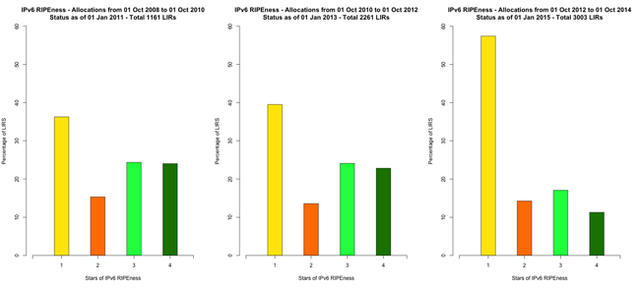
As may have been expected, LIRs with allocations from 2008-2010 were indeed not as "RIPE" by the start of 2011 as they were in 2015. However, the LIRs with allocations received under the last /8 policy do still stand out as having a notably larger percentage of one-star RIPEness compared to LIRs from the other groups at similar points in time. This difference could be a direct effect of the last /8 policy, but it could also be caused by other factors. As noted earlier in this article, the nature of organisations joining the RIPE NCC changed too in recent years. That may be a reason why fewer LIRs in the last group have made a (modest) start with IPv6.
The RIPE Address Policy Working Group is discussing whether to amend the last /8 policy (see policy proposal 2014-04 , “Removing IPv6 Requirement for Receiving Space from the Final /8”). The working group co-chairs are currently evaluating the feedback received during the Last Call phase of this policy proposal and will decide whether consensus has been reached.
Conclusion
Since the RIPE NCC IPv4 free pool fell to the limit of the last /8, new LIRs sign up with the RIPE NCC in ever increasing numbers. At the same time, older LIRs are closing. The combined trends still lead to steady growth, but the demographics of the membership are changing rapidly; an ever-growing fraction has signed up in the last five years.
Final IPv4 allocations from the last /8 are likely the main reason for organisations to open a new LIR. Most organisations with IPv4 addresses from the last /8 stay within the spirit of the policy; they hold just one /22 allocation. However, by 1 January 2015 we find 3% of the LIRs with address space from the last /8 have obtained more than one allocation - not directly from RIPE NCC, but indirectly via transfers, mergers or acquistions. The most extreme case thus far is a single LIR with 21 allocations from 185.0.0.0/8. Whether these practices call for changes in policies and procedures is something for the RIPE community and the RIPE NCC members to decide.
The IPv6 RIPEness measurements as an indicator of steps towards IPv6 deployment show LIRs that received the IPv6 allocation under the policy for the last IPv4 /8 tend to be less "RIPE" than other LIRs holding IPv6 at equivalent points in history. The requirement of holding an IPv6 allocation in order to become eligible for a final /22 IPv4 allocation might play a role here. It will be interesting to track how the RIPEness level of this group evolves. Will many more of them reach the fourth star?

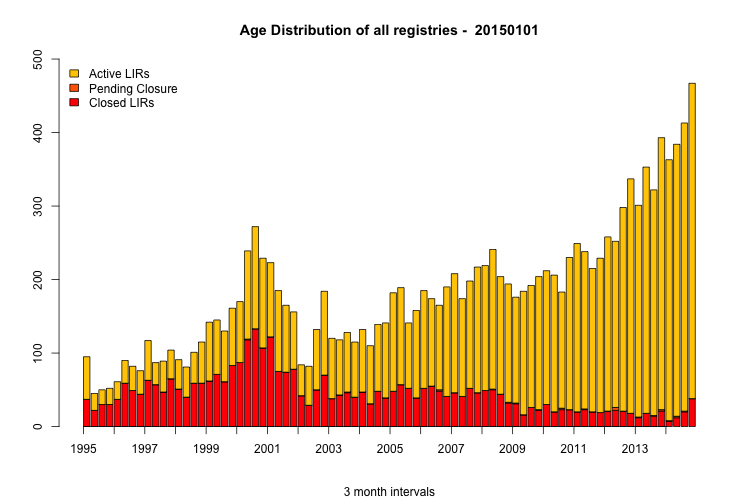
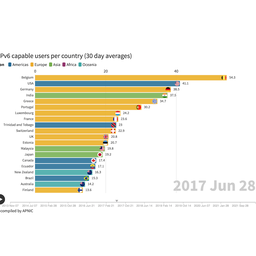

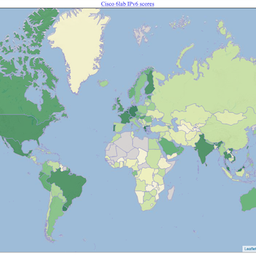
Comments 0
The comments section is closed for articles published more than a year ago. If you'd like to inform us of any issues, please contact us.